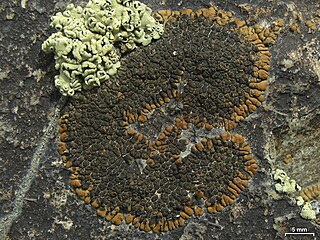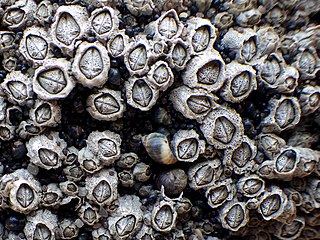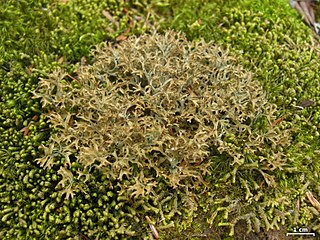
Bacidina is a genus of lichens in the family Ramalinaceae. It was circumscribed by Czech lichenologist Antonín Vězda in 1990, with Bacidina phacodes assigned as the type species. Vězda included 11 species in Bacidina, which was originally classified in the Lecideaceae. These species had previously been placed in genus Bacidia.
Waynea is a genus of lichenized fungi in the family Ramalinaceae. It was circumscribed in 1990 by Swedish taxonomist Roland Moberg, with W. californica assigned as the type species.

Micarea is a genus of lichenized fungi in the family Pilocarpaceae. The widely distributed genus contains 126 species and new species are described actively. Species in the genus are crustose lichens and their photobiont is a single-celled green alga.

Lecanographa is a genus of about 40 species of lichens in the family Lecanographaceae. It was circumscribed in 1994 by José M. Egea and Pilar Torrente, with Lecanographa lyncea as the type species.

Sphaerellothecium is a genus of fungi in the family Phyllachoraceae. All of the species in the genus are lichenicolous, meaning they grow parasitically on lichens.

Xanthopyreniaceae is a family of lichen-forming fungi in the order Collemopsidiales. The family was circumscribed by lichenologist Alexander Zahlbruckner in 1926.
Zwackhiomyces is a genus of lichenicolous fungi in the family Xanthopyreniaceae. The genus was circumscribed by Martin Grube and Josef Hafellner in 1990, with Zwackhiomyces coepulonus assigned as the type species.

Absconditella is a genus of lichenised fungi in the family Stictidaceae. The genus was circumscribed in 1965 by Czech lichenologist Antonín Vězda, with Absconditella sphagnorum assigned as the type species. Absconditella is characterised by gyalectoid apothecia with a hymenium that is not amyloid, without a dark pigment and thalli containing green algae as photobionts. The genus name means "hidden", a reference to the scant structure of the thallus and its small apothecia.
Parmotrema aberrans is a species of lichen in the family Parmeliaceae. It is found in the Neotropics, from Mexico to Paraguay. The species was originally described by Edvard August Vainio in 1890 as a form of Parmelia xanthina. In 1958, Henry Nicollon des Abbayes promoted it to species level within Parmelia. Luciana Canêz and Marcelo Marcelli transferred it to Parmotrema in 2008.
Catillaria flexuosa is a species of crustose lichen in the family Catillariaceae. It is found in the south of the Netherlands, where it grows on the bark of roadside ash trees.
Didymocyrtis trassii is a species of lichenicolous (lichen-eating) fungus in the family Phaeosphaeriaceae. It is found in southern Ukraine, where it parasitises the foliose lichen Cetraria aculeata growing on sand dunes.
Zwackhiomyces polischukii is a species of lichenicolous (lichen-eating) fungus in the family Xanthopyreniaceae. It occurs in Ukraine, where it parasitises the crustose lichens Bacidia fraxinea and B. rubella.
Graphium samogiticum is a little-known species of lichenicolous (lichen-eating) fungus in the family Microascaceae. It is found in Lithuania, where it parasitises two lichen species that inhabit abandoned gravel pits.
Opegrapha verseghyklarae is a little-known species of lichenicolous (lichen-eating) fungus in the family Teloschistaceae. It is found in the Russian Far East, where it grows on the thalli and apothecia of the crustose lichen Ochrolechia pallescens.

Pseudocyphellaria glabra is a species of corticolous (bark-dwelling), foliose lichen in the family Peltigeraceae. It has a pale-green upper thallus surface, a white medulla and white pseudocyphellae.
Muellerella lecanactidis is a species of lichenicolous (lichen-dwelling) fungus in the family Verrucariaceae. It was formally described as a new species in 2003 by Paul Diederich and Pieter van den Boom, from specimens collected in California. The authors thought that the type specimen was parasitising a lichen from genus Lecanactis, hence the species epithet, but it was later discovered that the host was actually Sigridea californica.
Phacopsis vulpicidae is a species of lichenicolous (lichen-dwelling) fungus in the family Parmeliaceae. It was formally described as a new species in 2019 by mycologists Mikhail P. Zhurbenko and Paul Diederich. The type specimen was collected by the first author near the headwaters of Ar Khordolyn gol River in Renchinlkhümbe Somon, at an altitude of 2,050 m (6,730 ft). There, in the upper limit of a Larix sibirica forest, the fungus was found growing on the thallus of a ground-dwelling Vulpicida juniperina lichen. The species epithet vulpicidae refers to the genus of its host. Infections by the fungus cause blister-like (bullate) swellings of the host thallus. It is known to occur in arctic and mountain tundra and taiga biomes of Asia, Europe, and North America (Alaska). Its only recorded host is Vulpicida juniperina, and almost all recorded host specimens have been terricolous.
Crittendenia is a genus of lichenicolous (lichen-dwelling) fungi in the monogeneric family Crittendeniaceae. The genus was circumscribed in 2021 to contain two species, C. lichenicola, and the type, C. coppinsii. An additional 16 species were added to the genus the following year. The genus name honours British lichenologist Peter Crittenden.

Cetraria laevigata is a species of ground-dwelling, fruticose (bushy) lichen in the family Parmeliaceae. It was formally described as a new species by Russian lichenologist Kseniya Aleksandrovna Rassadina in 1943. In North America, it is commonly known as the striped Iceland lichen.
Heteroacanthella ellipsospora is a species of fungus of uncertain familial placement in the order Auriculariales. The fungus is lichenicolous (lichen-dwelling), and it parasitises the apothecia and thallus of the crustose lichen Lecanora carpinea. Heteroacanthella ellipsospora was formally described as a new species in 2014 by Juan Carlos Zamora, Sergio Pérez-Ortega and Víctor Rico. It was first described from specimens collected in the Spanish provinces of Jaén and Madrid, and later reported from Sweden.







